El planeamiento tributario como instrumento de gestión y su importancia en el riesgo fiscal
DOI:
https://doi.org/10.53641/junta.v6i2.121Palabras clave:
Planeamiento estratégico, planeamiento tributario, riesgo fiscal, estabilidad macroeconómicaResumen
El presente trabajo de investigación busca demostrar las bondades del planeamiento tributario, así como los efectos en cuanto al riesgo fiscal entendido éste como
un mecanismo que busca la estabilidad macroeconómica y la equidad social. El planeamiento tributario es una herramienta de gestión que facilita todo mecanismo para proyectar las actividades propias de las instituciones en busca de lograr sus objetivos primordiales, a través de este, se plasman todas las formas necesarias para orientar a los responsables del manejo de una institución financiera. Su buena aplicación permitirá que los responsables del manejo económico y financiero eviten riesgos innecesarios para lograr la estabilidad macroeconómica y la equidad social. La población objeto de estudio lo constituyen las entidades públicas y privadas que tienen a su cargo el manejo de fondos públicos y privados, las cuales por su naturaleza propia están expuestas a riesgos de cambio, de liquidez, de mercado, de tasas de interés y similares. Su diseño es de tipo no experimental, por cuanto no se puede manipular variables ni generalizar resultados y, de igual manera, su estudio está orientado a trabajar con hechos ya ocurridos en su contexto natural. En lo referente
a los procedimientos y técnicas de investigación, se recurre a la recolección de información como parte de la argumentación, y en cuanto a las técnicas, se recurre al análisis documental, que se utiliza para analizar los documentos y normas relacionadas a la práctica del manejo financiero en toda su extensión. Se justifica la importancia del planeamiento estratégico como disciplina e instrumento de gestión para evitar los riesgos financieros en las entidades de manejo de fondos públicos y privados bajo sus distintas características para procurar el bienestar económico social.
Descargas
Citas
Barragán Arqué, P. (1999). Reseña histórica de la administración tributaria en el Perú. Gestión En El Tercer Milenio, 2(3), 73–80.
Belaunde, G. (10 de noviembre del 2018). Riesgos fiscales institucionales o estructurales. Gestión.
Centro Nacional de Planeamiento Estratégico (2016). Plan de Desarrollo Concertado, el Plan Nacional de Desarrollo estratégico al 2021. CEPAL.
Centro Nacional de Planeamiento Estratégico (2019). Plan Nacional de Desarrollo Económico y Social hasta 2030. PNUD y CEPAL.
Centro Nacional de Planeamiento Estratégico (2022). Plan Estratégico de Desarrollo Nacional al 2050. CEPAL.
Conexión ESAN (07 de marzo 2016). ¿Qué es el planeamiento tributario y qué se requiere para implementarlo? ESAN.
Villegas, E. (2004). La planeación fiscal en nuestros días.
De Arespacochaga, J. (1998). Planificación fiscal internacional. Editorial Marcial Pons.
Decreto Legislativo N.o 1088 [Ministerio de Justicia y Derechos Humanos]. Que crea la ley del sistema nacional de planeamiento y del centro nacional de planeamiento estratégico. 27 de junio de 2008.
Fondo Monetario Internacional (FMI). (2016). Informe anual.
Instituto Peruano de Economía (26 de octubre de 2020). Los riesgos que enfrenta nuestra economía. IPE.
Lora Rocha, O. (11 de setiembre 2017). ¿Qué son los riesgos fiscales y cómo manejarlos? IADB Blog.
Morón Maguiño, K. (2022). Planeamiento tributario y su incidencia en la recaudación fiscal de las pequeñas empresas constructoras de la Región Ica periodos 2017-2018. [Tesis de maestría, UNMSM]
Picón & Asociados (2022). ¿Qué es el planeamiento tributario? Picón & Asociados.
Plaza Vidaurre, V. (2019). ¿Cuál es la importancia del planeamiento? Blog Escuela de Posgrado.
Resolución N° 026-2017/CEPLAN/PCD [Ministerio del Interior]. Que aprueba la Directiva N°001-2017-CEPLAN/PCD Directiva para la Actualización del Plan Estratégico de Desarrollo Nacional. 15 de octubre de 2017.
Rivas Coronado, N. (2000). Planificación Tributaria. Editorial Magril.
RSM Perú (10 de diciembre de 2019). ¿Qué es el planeamiento estratégico? RSM Perú.
Ruiz Toledano, J. (1995). Fraude de Ley y otros supuestos de elusión fiscal. Editorial CISS. Soledad Recabarren Galdames. Recabarren & Asociados.
Descargas
Publicado
Cómo citar
Número
Sección
Licencia
Derechos de autor 2024 Pedro Nicanor Azabache De La Cruz, Esli Jemina Villanueva Amoroto

Esta obra está bajo una licencia internacional Creative Commons Atribución 4.0.








